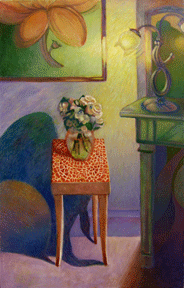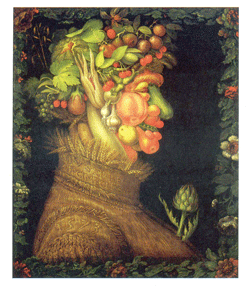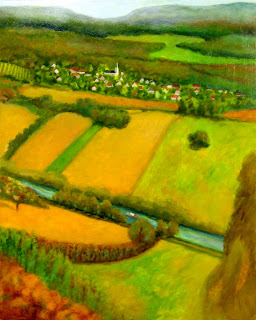
Wednesday, December 9, 2009
An Unconventional Holiday Tree

Sunday, November 29, 2009
Back From Morocco



Saturday, October 3, 2009
"Images with Multiple Meanings"






Sunday, September 20, 2009
Dialogues Within My Paintings

After several sketches, I take a photo one evening with light coming only from the lamp on the dressing table. Often dramatic lighting will enliven and begin the dialogue between the objects.
Voila! I see the beginning of a painting.


Sunday, September 13, 2009
Looking Forward to Fall 2009

In all the examples from previous summers the oil paintings are enclosed in panels of fusion glass that contain snippets of leaves and blossoms on a painted background. Everything in the fusion glass frame comes from the garden depicted in the painting.



“Nasturtiums 1” is the first of several oil paintings that I made recently of some plants I purchased for my decorative pots. I especially loved the legginess of the nasturtiums and was happy to have grabbed the last two left at Lynch’s one afternoon in early July. The dancing lines were inspired by the random marks that I made in my pencil sketches.
Sunday, August 30, 2009
Summer 2009

Is this a tomato only an artist could love? Heirloom tomatoes have a taste that is the essence of summer, but they are some of the ugliest tomatoes on the shelf according to market standards. The perfect tomato is genetically engineered to be round, uniformly deep red in color and has a skin tough enough to withstand rough handling, and yet.....
An heirloom tomato is pleasing to me as an artist because it is so outrageously odd. If I take an heirloom tomato as my subject in a painting its irrepressible color forces me to be bold with the entire composition. The fact that they inspire me has a lot to do with my transformation as an artist and the way that I paint today.

Early in my career as an illustrator I did a series of botanical watercolor paintings for the Del Monte Corporation. I was intrigued by the challenge of making my art look like an antique print done in the style of such masters as Pierre Redoute and Basilius Besler. I was also expected to be scientifically accurate and portray the botanical subjects as they had been engineered by Del Monte.
The difference between the perfect tomato in my botanical painting above and the tomato in Heirloom Supper below represents the evolution that has occurred in my work over the course of my career.. Now, with confidence in my painting technique, draftsmanship and use of color, I have taken a seminal leap and plunged into doing work that chronicles an emotional attachment to my subjects.



The third example Heirloom Supper, is a painting with quite a different approach. I have taken the table setting and the tomatoes as my starting point, but there is no doubt that something else is going on here besides a still life. I am hoping the painting does more than razzle-dazzle you with interesting colors as I tried to set up a narrative using my subjects as a sort of drama. The small tableau is a landscape of emotionally charged elements that retain their sense of normality even with their clashing hues, a combination of strangeness and familiarity.
It is a style that is analogous to the contradictory nature of an heirloom tomato. Even though the tomato sports unusual and brutal colors the fruit inside is heavenly. Try some summer . . .
Simple Heirloom Tomato Tart
1 package frozen puff pastry sheet, defrosted
1 T. extra-virgin olive oil
6 big ripe heirloom tomatoes, thinly sliced
1/4 c. chopped fresh basil
salt and freshly ground pepper
1 cup grated parmesan cheese
Roll out dough to 1/8-inch thickness. Place on cookie sheet and brush with olive oil. Sprinkle half the cheese over dough and place tomato rounds overlapping on top. Add salt and pepper. Bake for 30 minutes in preheated 425 degree oven. Sprinkle remainder of cheese and cook 20 minutes more until brown. Finish with basil and let cool 15 minutes before cutting in serving pieces. Yummy!
Friday, August 28, 2009
Winter 2009




Sunday, August 23, 2009
Spring/Summer 2008





Saturday, August 15, 2009
Winter 2008

Every six months I will give you a look at what I’ve been working on and organize the material around a theme. By sharing my experience of barge cruising in France I hope to encourage others to explore this delightful mode of travel. This story starts with my friend Marie who had orchestrated an elaborate present for her husband Dan. Their spur of the moment trip to Paris would really be the beginning of a magical week long journey with six friends in celebration of his birthday. To catch him off guard, we waited hidden in the lobby of their hotel...Surprise! Happy Birthday!...then off to the Gare de Lyon and the train to Dijon. Before sunset we were on the deck of the Hirondelle toasting our hosts and our own good fortune for having such generous friends.
As we cruised the Canal de Borgogne we relaxed and completely absorbed the lovely countryside through all of our senses. Each morning we awoke to a beautiful petit dejeuner freshly prepared by our chef Selby. The barge would begin its journey as we ate and later, when we entered one of the many locks, we would jump off and bike, jog or stroll along the canal pathway. Next to each lock was the lock-keepers cottage, often with a lovely garden as you can see in the photograph below.

After lunch we usually visited a vineyard in the Cote d’Or region of Burgundy, where the Pinot Noir wines are produced from that famously difficult grape. We learned about the terroir, a term for the combination of soil, climate and typography, that infuses the wine with a complex taste.
We also visited many chateaux and my favorite was the Chateau de Longecourt, a wonderful 12th century castle just south of Dijon. Our guide was Roland, the Count of Longecourt, whose family has lived there since 1631. The charm of the place was, in large part, due to the ambiance of faded glory as well as the self-effacing nature of the jeans clad Roland. Everywhere I looked there was a still-life worthy of a painting and I captured many on film for later enjoyment. One such scene was of a gathering of overgrown potted plants and crumbing stone work in the corner of the courtyard that is shown below.
My gift to Dan was going to be a visual record of his birthday cruise and, to that end, I had brought a sketch pad, watercolors and pencils. Here you can see the final product that I completed in the studio. The box contains, among other things, some small paintings of the places we visited, the people on the trip and the logo for the outfitters of our cruise: Afloat in France. In the center, a demi-bouteille of wine bears a label fashioned after that of the Chateau de Pommard where we all had purchased a case of wine. Surrounding the assemblage is a frame containing leaves and flowers gathered along the canal.
The approaching winter chill in the air yielded up a spectacular autumn and each morning we awoke to survey a new palette of colors as more leaves had magically turned red and orange during the night. The grapevines were the most breathtaking of all: a deep russet with accents of alizarin crimson shimmering in contrast to the few remaining clusters of ebony grapes. Some of the trees remained green and were festooned with large balls that reminded us of Christmas ornaments. Later we learned that they were bunches of mistletoe.
When we reached the city of Dijon, the first place on everyone’s list to visit was the mustard shop where they sell moutard dispensed fresh from a mustard tap in beautiful ceramic jars. Below is a recipe for using our special Dijon mustard--mailed to each of us from Paula, one of the members of our group.
Beet and Spinach Salad
1 1/4 pounds beets, trimmed and rinsed
1 1/2 teaspoons rice vinegar
1/4 teaspoon freshly ground pepper
1/2 teaspoon kosher salt
1 tablespoon extra-virgin olive oil
1/4 teaspoon whole-grain dijon mustard
1 ounce spinach leaves, sliced (1 cup)
3 tablespoons toasted walnuts
1 ounce blue cheese, crumbled
Preheat the oven to 400 degrees.
Place beets in a roasting pan with water to 1/2 inch. Cover and bake until beets are easily pierced with fork, about 1 hour. Set aside to cool. Peel and rinse. Slice into 1/2 inch thick rounds, then cut into 1/4 inch sticks. Add the vinegar, salt and pepper, olive oil and mustard and toss with the spinach. Garnish with walnuts and blue cheese.
Bon Appetit!







-cop.jpg)










